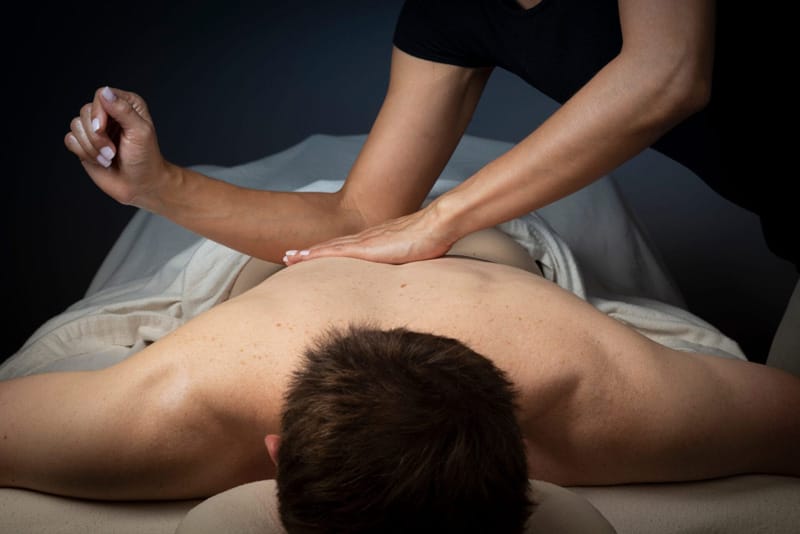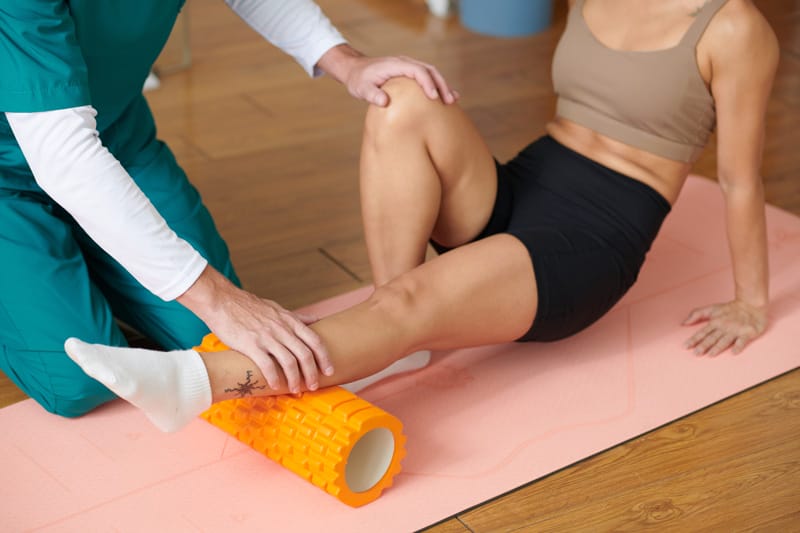
Why Myofascial Release Therapy
Myofascial release therapy is a hands-on technique that works to relax, lengthen and realign your fascia. Often, adhesions in our fascia and muscles can restrict movement and create painful trigger points (muscle knots) leading to various sources of acute and chronic pain. Myofascial release therapy uses deep tissue work at specific muscle groups that aims to release the surrounding tissues and muscles to increase tissue length and decrease stiffness. The goal is to bring you pain relief, as well as give you back your functional range of motion, improved posture, and can improve performance and strength.
What are the benefits of myofascial release therapy?
- Reduced pain and stiffness: By releasing tension in the fascia, myofascial release can alleviate pain and discomfort throughout your body.
- Improved mobility and flexibility: Less tension and muscle restrictions will result in an increased range of motion, allowing you to feel looser and more flexible.
- Enhanced athletic performance: Improved flexibility and reduced muscle tension can lead to better performance and a quicker recovery after exercise.
- Improved posture and body alignment: Addressing fascial restrictions can help improve your posture and overall body mechanics.
- Reduced stress and tension: Myofascial release can promote relaxation and a sense of well-being by easing tension throughout your body.
This technique is used to treat multiple injuries (such as jumper’s knee, patellar tracking issues, IT band syndrome, rotator cuff injuries, postural dysfunctions such as upper or lower cross syndrome) and is part of the treatment provided here at PhysioDNA. Tightness and tension in the fascia can contribute to pain, restricted mobility, and decreased performance – therefore this technique is performed by our physiotherapists, chiropractors, massage therapists and fascial stretch therapists.
Who can benefit from myofascial release therapy?
- Individuals suffering from pain and stiffness
- Athletes seeking to improve performance in their sport
- Individuals who may not necessarily have pain, but often feel stiff with limited flexibility
- Those looking to prevent injury from occurring in the first place – by addressing muscle and fascial tension before it becomes a problem

You will be able to feel the benefits of this treatment instantaneously! Schedule an appointment in Bloor West Village, Oakville, or downtown Toronto today to experience the freedom of movement that myofascial release therapy can bring you!
How does Myofascial release therapy help with runners!?
Myofascial release therapy can be highly beneficial for runners in several ways:
- Improved Flexibility and Range of Motion: Myofascial release helps to alleviate tightness in the muscles and connective tissue (fascia), which can improve overall flexibility and range of motion. This is crucial for runners, as increased flexibility can enhance stride efficiency and reduce the risk of injury.
- Reduction of Muscle Soreness and Recovery Time: By releasing tension in the fascia and muscles, myofascial release can help decrease post-run soreness and speed up recovery. This allows runners to train more consistently and with less discomfort.
- Prevention of Injuries: Tight fascia can lead to imbalances and improper movement patterns, which may increase the likelihood of injuries like plantar fasciitis, IT band syndrome, or shin splints. Myofascial release helps to keep the fascia pliable, reducing these risks.
- Enhanced Circulation: The therapy can improve blood flow to the muscles, which is essential for delivering nutrients and oxygen to tissues, promoting faster healing and better overall performance.
- Pain Relief: For runners dealing with chronic pain or specific trigger points, myofascial release can be an effective way to alleviate pain by addressing the root cause—tight and restricted fascia.
- Mental Relaxation: The process of myofascial release can also be calming, helping runners to reduce stress and tension, which can be beneficial for both mental and physical performance.
Benefits with chronic back pain:
- Targeting Fascia-Related Tension: Chronic back pain is often related to tension and tightness in the fascia, the connective tissue that surrounds muscles. Myofascial release helps to alleviate this tension, reducing pain.
- Releasing Trigger Points: Trigger points, or “knots,” in the muscles and fascia can cause referred pain in the back. Myofascial release therapy specifically targets these points, helping to release them and alleviate the associated pain.
- Improving Posture and Mobility: Tight fascia can lead to poor posture, which is a common contributor to chronic back pain. By releasing fascial restrictions, myofascial release can improve posture and increase mobility, reducing the strain on the back.
- Reducing Inflammation: Myofascial release can help to improve circulation, which in turn can reduce inflammation in the affected areas. This reduction in inflammation can ease chronic back pain.
Related Blogs
FAQs
-
How is Myofascial Release Therapy different from traditional massage therapy?
Myofascial release therapy focuses on the problems in your tissues that cause your muscles to become tight and painful, while massage is about temporarily soothing sore and tight muscles.
-
Is Myofascial Release Therapy suitable for everyone, or are there specific contraindications?
Those who have sustained physical injuries or trauma may benefit from myofascial release treatment. Myofascial release therapy is recommended for patients who have been in an accident and suffered injuries, whiplash, developed scars from an incident, or other physical trauma.
-
What can I expect during a Myofascial Release Therapy session?
Myofascial release therapy is a kind of continuous, mild massage that helps your myofascial tissues become less painful and tense. Your doctor will first search your fascial tissues for trigger points, also known as knots. They will then gradually apply pressure until they experience a release of stress.
-
How many sessions of Myofascial Release Therapy are typically recommended for optimal results?
After only one session of myofascial release therapy, a lot of patients report feeling less uncomfortable or having a better range of motion. However, weekly, biweekly, or every other week sessions for four to twelve weeks are a realistic estimate of the needed time, depending on your requirements and circumstances.
-
Will I feel any pain during or after Myofascial Release Therapy?
After myofascial release therapy, you could feel a few of these symptoms: Achy Muscles: As the body rids itself of the released toxins, aches and pains are normal for around 24 hours following your treatment. Some get a feeling in their muscles similar to what you experience after a strenuous gym session.
-
Are there any aftercare instructions I should follow post-therapy?
To assist the body in rehydrating and removing toxins from the limited regions, drink a lot of water. Rest if you are able to because you are exhausted. Stretch as much as you can to release the stress built up after your tiring myofascial release therapy session.



